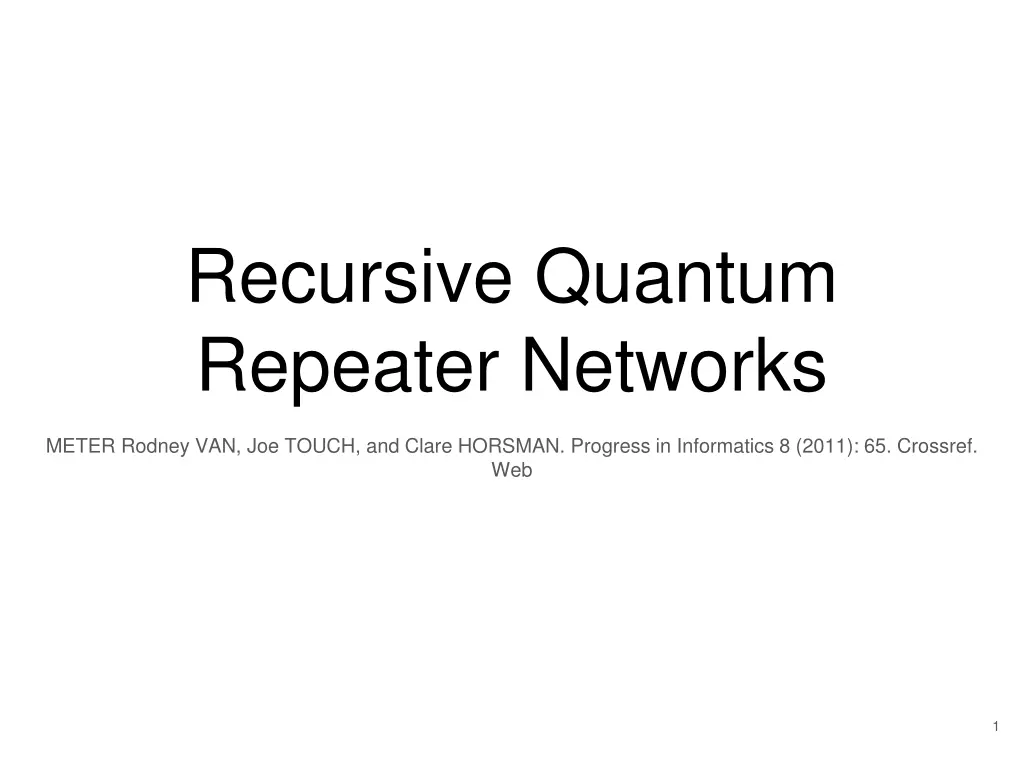
Recursive Quantum Repeater Networks Overview
"Explore the concept of recursive quantum repeater networks, discussing the TCP/IP protocol layers, quantum networks, transit networks, and the challenges of quantum data transmission. Discover how repeaters make decisions to build states efficiently."
Download Presentation

Please find below an Image/Link to download the presentation.
The content on the website is provided AS IS for your information and personal use only. It may not be sold, licensed, or shared on other websites without obtaining consent from the author. If you encounter any issues during the download, it is possible that the publisher has removed the file from their server.
You are allowed to download the files provided on this website for personal or commercial use, subject to the condition that they are used lawfully. All files are the property of their respective owners.
The content on the website is provided AS IS for your information and personal use only. It may not be sold, licensed, or shared on other websites without obtaining consent from the author.
E N D
Presentation Transcript
Recursive Quantum Repeater Networks METER Rodney VAN, Joe TOUCH, and Clare HORSMAN. Progress in Informatics 8 (2011): 65. Crossref. Web 1
Recursive Quantum Repeater Networks 1. Introduction 2. TCP/ IP protocol layers networks v.s. recursive networks 3. Quantum network 4. Recursive quantum request 5. Implements 2
1. Propose a unifying quantum framework that can be used with all existing repeater designs 3
TCP/ IP protocol layers networks 1. Static layering: physical layer, data layer, network layer, transport layer, application layer 2. Both inter-domain and intra-domain routing have to happen within the network layer - Addressing and routing problems 4
Recursive networks Subset of a network represented as a single node at a different layer of that network - Without requiring requesters to understand the detailed topology or technology of the network Transit networks - The networks that may form part of the path, but do not include nodes that are part of the requested state 5
Transit networks To external requesters: appears as a single node Internally, nodes within the network can in turn be networks, in recursive fashion. 6
Quantum network Qubits loss and degrade fidelity in optical channels - Purifications - Use repeaters proposed to be placed at short distance to connect Teleporting data hop-by-hop by repeaters is unworkable because imperfect local gates and memories - Create the end-to-end entangled state by entanglement swapping - Transmit not quantum data itself, but request for the execution of operations which will create new distributed, entangled states. 7
Recursive quantum request States - Repeaters will make both independent and coordinated decisions about which states to purify, swap, error correct, forward, buffer, and discard, as they build states that satisfy users requests. Naming a State - Nodes must be able to name states such that other repeaters will understand: do operation U on this particular state we share. Defining Quantum Requests - For a specific state, spanning a named set of nodes. 8
Naming a State The tuple (N,A), where N is the node name and A is the physical qubit address within the node, is not workable. As three keys: - Each node can move the logical state of a qubit from one physical qubit to another - Physical qubits are reused after being freed - Request may need to refer to the qubit by name even before physical resources for it are allocated 9
Naming a State Request may need to refer to the qubit by name even before physical resources for it are allocate - Ex. Request for a gate to be executed may be issued at the sametime as the initial entangling pulse virtual address - Allowing the original requesting node to assign a virtual address - Mapping on the node privately 10
Defining Quantum Requests No-less-than for the element corresponding to the desired state - Set Min fidelity (F) - Ensure closeness to state we want No-more-than for the elements corresponding to undesired states. - Set max entropy (S) - Filter out returned states that may be non-trivially entangled with other nodes in the system Encoding method of the quantum state (EA) 11
Defining Quantum Requests The tuple specifying a request: ID is transaction identifier assigned by the requester, ((Ni,Ai)) is the set of nodes that are requested to comprise the state and the virtual addresses Ai 12
